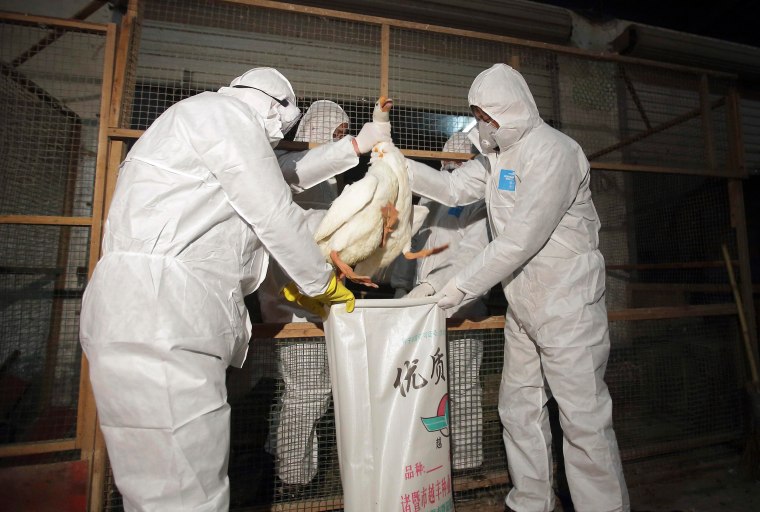The case of a Canadian woman who died of H5N1 bird flu earlier this month has mystified flu experts, who say they are both puzzled by how she got the virus, and more than a little surprised that it was H5N1 and not a newer virus, called H7N9, that infected her.
The woman’s unusual symptoms – she didn’t have some of the more obvious signs of flu – prompted a health alert from the U.S. Centers for Disease Control and Prevention this week reminding doctors to be on the lookout for odd symptoms.
“It caught us a little unawares because we were expecting this to happen with H7N9,” CDC flu expert Marc-Alain Widdowson told NBC News. “It came a little out of the blue.”
The victim, a 22-year-old nurse from the central Canadian province of Alberta, had encephalitis – a swelling of the tissue surrounding the brain. She also had pneumonia, but her flu infection wasn’t diagnosed right away and she apparently wasn’t coughing hard.
By the time she came back to the hospital a few days later, she was already dying. Severe and unusual symptoms are a hallmark of avian influenzas, doctors say.
The CDC says people coming back from countries affected by any kind of avian flu should be on the lookout. “Clinicians should consider the possibility of avian influenza A (H5N1) virus infection in persons exhibiting symptoms of severe respiratory illness who have appropriate travel or exposure history,” the Health Alert reads.
And travelers to affected regions should stay away from live or freshly killed birds and only eat meat or eggs that have been thoroughly cooked.
Since 2003, H5N1 has infected around 650 people in 16 countries – counting the latest case in Canada – and killed around 350 of them, according to the World Health Organization. In most cases, it causes severe pneumonia, acute respiratory distress syndrome, and, eventually, multiple organ failure. But experts say it sometimes causes encephalitis and septic shock.
The Canadian victim had been in China since early December and didn’t get really ill until she was headed home at the end of the month, so she almost certainly became infected while in Beijing. H5N1 does not spread easily from person to person, so experts are not alarmed and not worried that the traveler infected anyone else. But the CDC says the case is a reminder that infections other than seasonal flu might show up and doctors need to be alert.
“Clinicians and state health departments should also be aware that human infection with avian influenza A (H7N9) viruses have been reported among persons in China and Taiwan since April 2013, and may exhibit similar symptoms to those of influenza A (H5N1), including pneumonia, respiratory failure, and acute respiratory distress syndrome,” the CDC says.
Of course, this is extra tricky when seasonal influenza is also circulating and causes the same symptoms.
H7N9 has infected around 180 people in the past year – 18 in China in just the past week – and killed around a third of them. “There is a clear second wave that is ongoing now,” Widdowson said. “We expected this. This is the season for avian flu in that region of the world. We expected this winter to be busy.”
That’s also why health officials were on the lookout for bird flu in travelers. “We have been preparing for a traveler coming with H5 disease for many years now,” said Dr. Joe Bresee, another CDC flu expert.
But what everyone had really been looking for was either someone coming from China with H7N9, or if it was H5N1, for the traveler to have been in a region where H5N1 was circulating. Currently, it’s not being seen among people in China, although reports to the OIE, the world health organization for animals, show ongoing outbreaks among birds in several parts of China.
Initial interviews suggest the young Canadian nurse spent her whole time in Beijing, where there are strict rules about keeping, selling and slaughtering poultry. Kevin Fonseca, a clinical virologist for Alberta Health Services, filed a report with the International Society for Infectious Diseases saying the woman, who’s not being named, had no known contact with poultry.
That’s not entirely mysterious, Widdowson says. In the decade that H5N1 has been circulating, there have been a few cases where the patient had no apparent contact with poultry. It doesn’t pass easily from person to person but people might catch it from indirect contact with birds. And Widdowson says people do occasionally smuggle birds into Beijing from other parts of China.
“There are other routes other than actually physical touching a chicken that may cause H5 infection,” Widdowson said. “One is wild birds.” Wild waterfowl can carry H5N1. They can deposit the virus into ponds, too, and people have been infected by bathing in water that infected birds were in.
“You can be exposed to chickens without even knowing it,” Widdowson added. For instance, a vegetable vendor might be set up right next to a chicken seller. “You don’t need to be close,” Widdowson added.
The appearance of infection in a traveler to a region where H5N1 wasn’t seen to have been infecting people shows just how tricky influenza can be. “It’s a capricious virus. It always surprises us,” Widdowson said.
“I am mystified as anybody. It really is a strange event,” agreed Dr. Arnold Monto, a flu expert at the University of Michigan. “I don’t know if we will ever understand it.”
· Follow NBCNewsHealth on Facebook and on Twitter
· Follow Maggie Fox on Facebook and on Twitter
